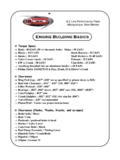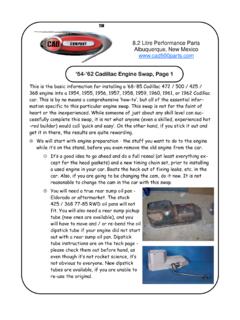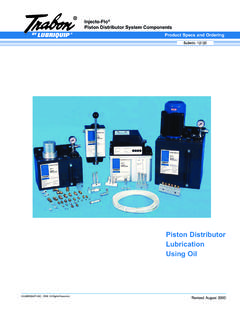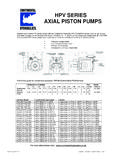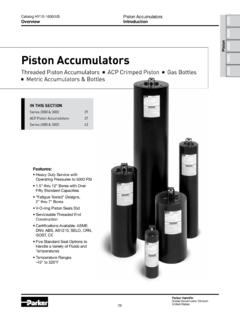Transcription of Cad Company Tech Pages: 8.2 Litre Performance Albuquerque ...
1 Cad Company Litre Performance Tech Pages: Phone: (505)823-9340. Fax: (505)797-0627. Albuquerque , NM Ignition Timing There are a number of issues affecting the ignition system that are common sources of trouble. The most common are the timing pointer, sticky mechanical advance, and the power source. Timing Mark: There are 6 different timing pointers, and the 0' mark is in a different place on each. As a result, the correct loca- tion of the permanent timing mark on the pulley needs to be in a different location for the different pointers. The following procedure will check the mark on the pulley and correct it. Get a piston stop that screws into the spark plug hole. A 14mm fine thread bolt will work, but you have to be care- ful not to hit the bolt with the piston too hard. Disconnect the battery. You need 2 markers 1 that is removable (such as white-out) and 1 that is permanent (such as an enamel paint pen).
2 Screw the piston stop into the spark plug hole so that it will stop the piston before the piston gets to top dead center, but is still fairly close to TDC. Turn the engine over by hand until the piston hits the stop Mark the pulley (using the non-permanent marker) in line with the 0' mark on the pointer. Turn the engine over the other way by hand until the piston hits the stop. Mark the pulley (using the non-permanent marker) in line with the 0' mark on the pointer. The correct location of the permanent timing mark on the pulley will be exactly way between the 2 tempo- rary marks you made. If that is not where the old timing mark on the pulley is, make a new permanent mark in the correct location that will be easy to tell which one is correct when using a timing light. Mechanical Advance: The cause of this problem is the distributor shaft lube.
3 The symptoms include timing that creeps' up while you watch, seems to be different each time you check it, or a car that acts like it has too much timing but the timing checks out (and you already checked the marks for accuracy). The mechanical advance operates by a collar rotat- ing on the shaft, which is supposed to be pulled one way by the lever action of the weights (for advance at higher RPM) and pulled back the other way by the springs (to retard at low RPM). The factory lube where this collar ro- tates on the distributor shaft is usually more like tar by now, than like grease. It is easy to diagnose and repair. Grab the rotor and twist it clockwise, then release. It should snap back sharply. Then try to turn it further counter clockwise, and you shouldn't be able to. If it creeps back, or doesn't snap all the way back, this is at least part of your tuning problem.
4 The timing is correct at cold idle, but once you rev the engine up and the mechanical advance takes effect, it doesn't go back until it has sat without running for a while. This is also easy to correct. Push the pin out that holds the gear on the shaft, and pull the shaft out the top. Disassemble the mechanical advance assembly by removing the springs and sliding the collar off of the shaft. Clean, and reassemble with fresh grease. The vacuum advance can suffer from a similar problem - the trigger ring rotates on the neck of the case, and is held in by a snap ring. Check this and clean / lube as needed while the shaft is out. Be careful not to use too much grease - excess grease will squish out during re-assembly, and then sling around the inside of the distributor cap when you start it up. This can be avoided by sliding the components together, then back apart to wipe of excess grease, then continuing with assembly.
5 Too Little Advance Note that some late engines, such as 425 and 368 engines have a timing pointer that reads to well over 20 degrees. Some of these engines had an HEI unit that looks just like the regular HEI, but has much less advance built in. These distributors need to be set at 20-24 degrees of base timing, not 8-12 degrees, or you will not have enough spark advance under heavy load and power will suffer dramatically. Power Supply Note that the power supply is different for electronic and points distributors. Vehicles originally wired for points will have power from the on / run' position of the ignition switch going through a resistor wire or ballast resistor, providing 6-8 volts, and a second wire coming from the starter providing 12 volts while cranking. Those wired for electronic ignition will have a single 12 volt supply from the ignition switch when it is in either the on / run' or start' position.
6 12 volts all the time will burn up points quick. Less than 12 volts will cause erratic or insufficient spark with an HEI. Voltage requirements of aftermarket ignitions vary. Make sure the power supplied to your dis- tributor / coil matches what it needs.
